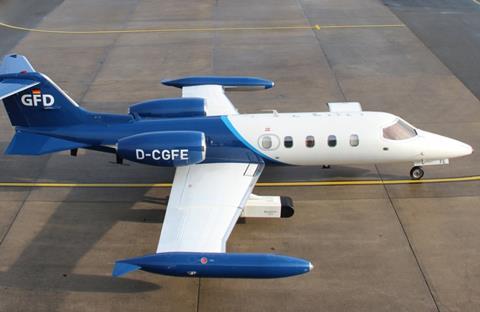German investigators have disclosed that the pilots of a Learjet 35A were training for a simulated engine failure at take-off when the aircraft fatally crashed at the Hohn military airfield.
The jet was the third of a group of six Learjets departing the airfield almost simultaneously for various flight activities on 15 May this year.
Two pilots were on board the aircraft which was assigned to fly to Wunstorf airfield in order to conduct instrument approaches for local controller training. The flight would also serve as a check ride for the flying pilot to extend his ratings on the type.
Cockpit-voice recordings show the crew carried out a before-start engine checklist and also conducted a yaw-damper check and full-travel check of the flight-control surfaces, says German investigation authority BFU.
The pilots intended a take-off with 8° flap and full thrust.
After being instructed to taxi to runway 26, the crew performed a before-take-off check and carried out an emergency briefing.

The aircraft took off and, according to the cockpit recording, the flying pilot instructed the monitoring pilot to retract the landing-gear and engage the yaw damper – a system which suppresses motion around the yaw axis.
Five seconds after lift-off, the monitoring pilot stated that a right-engine failure would be simulated. Thrust on the right engine was reduced, while the left engine continued to operate normally. The aircraft was travelling at about 160kt (296km/h).
After instructing “Damper on”, and receiving a confirmation, the flying pilot almost immediately began uttering a series of expletives.
Preliminary flight-data recorder information indicates the aircraft rolled sharply and excessively to the right, and pitched to nearly 60° nose-down.
BFU says that, according to witnesses, the aircraft snap-rolled during the climb, descended steeply at the end of the runway, and struck the ground. It was destroyed by fire and neither pilot survived.
The inquiry has yet to reach conclusions on the cause of the accident.
It points out that the aircraft had already operated a flight on the same day, which was also captured on the cockpit-voice recorder.
“With the exception of a sluggishness of the primary yaw-damper observed by the crew, and a switch to the secondary yaw damper, the recording contained no indications of technical problems,” says the inquiry.

Examination of the wreckage, two weeks after the crash, did not reveal any indication of technical impairment of controls, control cables, pulleys or linkages.
BFU says it has asked pilots about the behaviour of the aircraft during simulated engine failure, and been informed that the aircraft usually needed slight left-rudder trim.
As the thrust on one engine was reduced, it would typically begin yawing and then rolling towards the side of that engine – the faster the reduction of thrust, the more substantial the yaw and roll – but this could be compensated by rudder and aileron input.
BFU was also told that the aircraft modified with stabilising Avcon fins, which are fitted to the tail cone, showed less-pronounced yawing and rolling. The aircraft involved in the Hohn accident – a 1993 airframe registered D-CGFQ – did not have these fins.
Airbus subsidiary GFD, which provides flight support and simulation services to the military, was operating the Learjet. The company says GFD is fully co-operating with authorities to determine the cause of the crash.


























